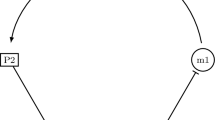Abstract
Control strategies for gene regulatory networks have begun to be explored, both experimentally and theoretically, with implications for control of disease as well as for synthetic biology. Recent work has focussed on controls designed to achieve desired stationary states. Another useful objective, however, is the initiation of sustained oscillations in systems where oscillations are normally damped, or even not present. Alternatively, it may be desired to suppress (by damping) oscillations that naturally occur in an uncontrolled network. Here we address these questions in the context of piecewise-affine models of gene regulatory networks with affine controls that match the qualitative nature of the model. In the case of two genes with a single relevant protein concentration threshold per gene, we find that control of production terms (constant control) is effective in generating or suppressing sustained oscillations, while control of decay terms (linear control) is not effective. We derive an easily calculated condition to determine an effective constant control. As an example, we apply our analysis to a model of the carbon response network in Escherichia coli, reduced to the two genes that are essential in understanding its behavior.
Similar content being viewed by others
References
Casey E, de Jong H, Gouzé J-L (2006) Piecewise-linear models of genetic regulatory netoworks: equilibria and their stability. J Math Biol 52: 27–56
Edwards R (2000) Analysis of continuous-time switching networks. Phys D 146: 165–199
Edwards R, Siegelmann HT, Aziza K, Glass L (2001) Symbolic dyanamics and computation in model gene networks. Chaos 11: 160–169
Elowitz MB, Liebler S (2000) A synthetic oscillatory network of transcriptional regulators. Nature 403: 335–338
Farcot E (2006) Some geometric properties of piecewise affine biological network models. J Math Biol 52: 373–418
Farcot E, Gouzé J-L (2008) A mathematical framework for the control of piecewise-affine models of gene networks. Automatica 44: 2326–2332
Filippov AF (1988) Differential equations with discontinuous right-hand sides. Kluwer, Dordrecht
Glass L (1975) Combinatorial and topological methods in nonlinear chemical kinetics. J Chem Phys 63: 1325–1335
Gouzé J-L, Sari T (2003) A class of piecewise linear differential equations arising in biological models. Dyn Syst 17: 299–316
Grognard F, de Jong H, Gouzé J-L et al (2007) Piecewise-linear models of genetic regulatory networks: theory and example. In: Queinnec I (eds) Biology and control theory: current challenges.. Lecture notes in control and information sciences (LNCIS), vol 357, Springer, pp 137–159
Guantes R, Poyatos JF (2006) Dynamical principles of two-component genetic oscillators. PLoS Comput Biol 2: e30
Hasty J, Isaacs F, Dolnik M, McMillen D, Collins JJ (2001) Designer gene networks: towards fundamental cellular control. Chaos 11: 207–220
Isaacs FJ, Dwyer DJ, Collins JJ (2006) RNA synthetic biology. Nat Biotech 24: 545–554
Isaacs FJ, Dwyer DJ, Ding C, Pervouchine DD, Cantor CR, Collins JJ (2004) Engineered riboregulators enable post-transcriptional control of gene expression. Nat Biotechnol 22: 841–847
Kobayashi H, Kærn M, Araki M, Chung K, Gardner TS, Cantor CR, Collins JJ (2004) Programmable cells: interfacing natural and engineered gene networks. Proc Natl Acad Sci 101: 8414–8419
Mackey M, Glass L (1977) Oscillation and chaos in physiological control systems. Science 197: 287–289
Maxwell A (1999) DNA gyrase as a drug target. Biochem Soc Trans 27: 48–53
Mestl T, Plahte E, Omholt SW (1995) Periodic solutions in systems of piecewise-linear differential equations. Dyn Stabil Syst 10: 179–193
Plahte E, Kjøglum S (2005) Analysis and generic properties of gene regulatory networks with graded response functions. Phys D 201: 150–176
Ropers D, de Jong H, Page M, Schneider D, Geiselmann J (2006) Qualitative simulation of the carbon starvation response in Escherichia coli. BioSystems 84: 124–152
Tigges M, Marquez-Lago TT, Stelling J, Fussenegger M (2009) A tunable synthetic mammalian oscillator. Nature 457: 309–312
Author information
Authors and Affiliations
Corresponding author
Rights and permissions
About this article
Cite this article
Edwards, R., Kim, S. & van den Driessche, P. Control design for sustained oscillation in a two-gene regulatory network. J. Math. Biol. 62, 453–478 (2011). https://doi.org/10.1007/s00285-010-0343-y
Received:
Revised:
Published:
Issue Date:
DOI: https://doi.org/10.1007/s00285-010-0343-y




